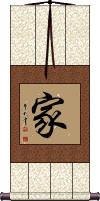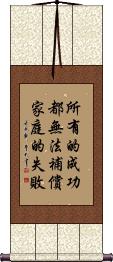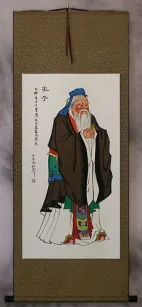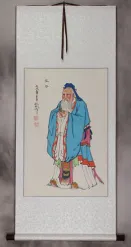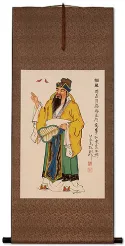Many custom options...
And formats...

Family Home in Chinese / Japanese...
Buy a Family Home calligraphy wall scroll here!
Personalize your custom “Family Home” project by clicking the button next to your favorite “Family Home” title below...
Family / Home
家 is the single character that means family in Chinese and Japanese.
It can also mean home or household depending on context.
Hanging this on your wall suggests that you put “family first.”
Pronunciation varies in Japanese depending on context. When pronounced “uchi” in Japanese, it means home, but when pronounced “ke,” it means family.
![]() Note that there is an alternate form of this character. It has an additional radical on the left side but no difference in meaning or pronunciation. The version shown above is the most universal, and is also ancient/traditional. The image shown to the right is only for reference.
Note that there is an alternate form of this character. It has an additional radical on the left side but no difference in meaning or pronunciation. The version shown above is the most universal, and is also ancient/traditional. The image shown to the right is only for reference.
Any success can not compensate for failure in the home
This in-stock artwork might be what you are looking for, and ships right away...
Gallery Price: $61.00
Your Price: $33.88
Gallery Price: $100.00
Your Price: $49.77
Chinese Village Home Landscape Painting
Discounted Blemished
Gallery Price: $90.00
Your Price: $49.00
Gallery Price: $120.00
Your Price: $79.88
Gallery Price: $400.00
Your Price: $188.88
Gallery Price: $400.00
Your Price: $188.88
Gallery Price: $400.00
Your Price: $138.88
Gallery Price: $61.00
Your Price: $33.88
Gallery Price: $72.00
Your Price: $39.88
Gallery Price: $60.00
Your Price: $39.88
Not the results for family home that you were looking for?
Below are some entries from our dictionary that may match your family home search...
| Characters If shown, 2nd row is Simp. Chinese |
Pronunciation Romanization |
Simple Dictionary Definition |
家 see styles |
jiā jia1 chia karyuu / karyu かりゅう |
More info & calligraphy: Family / Home(suffix) (colloquialism) (kana only) (See ん家) 's house; 's home; (surname) Karyū Family; home; school, sect; genus. |
家庭 see styles |
jiā tíng jia1 ting2 chia t`ing chia ting katei / kate かてい |
More info & calligraphy: Family / Householdhome; household; family; hearth household |
惣領 see styles |
souryou / soryo そうりょう |
More info & calligraphy: First Born |
釋迦牟尼 释迦牟尼 see styles |
shì jiā móu ní shi4 jia1 mou2 ni2 shih chia mou ni Shakamuni |
More info & calligraphy: Shakyamuni / The Buddha釋迦文 (釋迦文尼); 釋伽文 Śākyamuni, the saint of the Śākya tribe. muni is saint, holy man, sage, ascetic monk; it is: intp. as 仁 benevolent, charitable, kind, also as 寂默 one who dwells in seclusion. After '500 or 550' previous incarnations, Śākyamuni finally attained to the state of Bodhisattva, was born in the Tuṣita heaven, and descended as a white elephant, through her right side, into the womb of the immaculate Māyā, the purest woman on earth; this was on the 8th day of the 4th month; next year on the 8th day of the 2nd month he was born from her right side painlessly as she stood under a tree in the Lumbinī garden. For the subsequent miraculous events v. Eitel. also the 神通遊戲經 (Lalitavistara), the 釋迦如來成道記, etc. Simpler statements say that he was born the son of Śuddhodana, of the kṣatriya caste, ruler of Kapilavastu, and Māyā his wife; that Māyā died seven days later, leaving him to be brought up by her sister Prājapati; that in due course he was married to Yaśodharā who bore him a son, Rāhula; that in search of truth he left home, became an ascetic, severely disciplined himself, and finally at 35 years of age, under a tree, realized that the way of release from the chain of rebirth and death lay not in asceticism but in moral purity; this he explained first in his four dogmas, v. 四諦 and eightfold noble way 八正道, later amplified and developed in many sermons. He founded his community on the basis of poverty, chastity, and insight or meditation, ad it became known as Buddhism, as he became known as Buddha, the enlightened. His death was probably in or near 487 B.C., a few years before that of Confucius in 479. The sacerdotal name of his family is Gautama, said to be the original name of the whole clan, Śākya being that of his branch, v. 瞿, 喬.; his personal name was Siddhārtha, or Sarvārthasiddha, v. 悉. |
房 see styles |
fáng fang2 fang bou / bo ぼう |
house; room; CL:間|间[jian1]; branch of an extended family; classifier for family members (or concubines) (1) chamber; room; cell (prison); atrium; (2) (See 坊・2) home of a monk; monk; (3) {astron} (See 二十八宿,蒼竜・そうりょう・3) Chinese "room" constellation (one of the 28 mansions); (surname) Bou House, room. The rooms for monks and nuns in a monastery or nunnery. |
お宅 see styles |
otaku おたく |
(1) (honorific or respectful language) your house; your home; your family; (2) (honorific or respectful language) your husband; (3) (honorific or respectful language) your organization; (pn,adj-no) (4) (honorific or respectful language) you (referring to someone of equal status with whom one is not especially close) |
一家 see styles |
yī jiā yi1 jia1 i chia hitotsuya ひとつや |
the whole family; the same family; the family ... (when preceded by a family name); group (1) a family; a household; a home; one's family; whole family; (2) (one's own) style; school; (3) gang; (yakuza) family; (surname) Hitotsuya one school |
世帯 see styles |
setai せたい shotai しょたい |
household; home; family; housekeeping |
俗家 see styles |
sú jiā su2 jia1 su chia zokke |
layman; layperson; original home of a monk secular family |
八覺 八觉 see styles |
bā jué ba1 jue2 pa chüeh hachikaku |
The eight (wrong) perceptions or thoughts, i.e. desire; hate; vexation (with others); 親里 home-sickness; patriotism (or thoughts of the country's welfare); dislike of death; ambition for one's clan or family; slighting or being rude to others. 華嚴經 13. |
家主 see styles |
jiā zhǔ jia1 zhu3 chia chu yanushi(p); ienushi; iearuji(ok) やぬし(P); いえぬし; いえあるじ(ok) |
head of a household (1) (やぬし, いえぬし only) landlord; landlady; (2) house owner; home owner; head of the household kulapati, the head of a family. |
家信 see styles |
jiā xìn jia1 xin4 chia hsin ienobu いえのぶ |
letter to or from home or family word from home; (surname) Ienobu |
家内 see styles |
yanai やない |
(1) (かない only) (humble language) (my) wife; (2) inside the home; one's family; (surname) Yanai |
家宴 see styles |
jiā yàn jia1 yan4 chia yen |
dinner party held in one's home; family reunion dinner |
家用 see styles |
jiā yòng jia1 yong4 chia yung kayou / kayo かよう |
home-use; domestic; family expenses; housekeeping money (noun - becomes adjective with の) domestic uses |
家訓 家训 see styles |
jiā xùn jia1 xun4 chia hsün kakun; kakin かくん; かきん |
instructions to one's children; family precepts family precepts; family motto; rule of the home family precepts |
家風 家风 see styles |
jiā fēng jia1 feng1 chia feng kafuu; iekaze / kafu; iekaze かふう; いえかぜ |
(1) family tradition; (2) (いえかぜ only) (archaism) wind blowing from the direction of one's home family style |
居士 see styles |
jū shì ju1 shi4 chü shih koji こじ |
(1) {Buddh} (See 大姉・だいし) grhapati (layman; sometimes used as a posthumous suffix); (2) private-sector scholar 倶欏鉢底; 迦羅越 kulapati. A chief, head of a family; squire, landlord. A householder who practises Buddhism at home without becoming a monk. The female counterpart is 女居士. The 居士傳 is a compilation giving the biography of many devout Buddhists. |
屋企 see styles |
wū qǐ wu1 qi3 wu ch`i wu chi |
(Cantonese) home; family (Mandarin equivalent: 家[jia1]) |
山外 see styles |
shān wài shan1 wai4 shan wai yamasoto やまそと |
{Buddh} (See 山家・さんげ) Off-Mountain School (of Song-period Tiantai Buddhism); (surname) Yamasoto A branch of the Tiantai School founded by 晤恩 Wu En (d. A. D. 986) giving the 'shallower' interpretation of the teaching of this sect; called Shan-wai because it was developed in temples away from the Tiantai mountain. The 'Profounder' sect was developed at Tien-tai and is known as 山家宗 'the sect of the mountain family ' or home sect. |
庭訓 庭训 see styles |
tíng xùn ting2 xun4 t`ing hsün ting hsün teikin / tekin ていきん |
tuition within family; education from father (archaism) home education |
御宅 see styles |
otaku おたく |
(1) (honorific or respectful language) your house; your home; your family; (2) (honorific or respectful language) your husband; (3) (honorific or respectful language) your organization; (pn,adj-no) (4) (honorific or respectful language) you (referring to someone of equal status with whom one is not especially close) |
我家 see styles |
wagie; waie; wagae わぎえ; わいえ; わがえ |
(archaism) (See 我が家) one's house; one's home; one's family |
所帯 see styles |
shotai しょたい |
household; home; family; housekeeping |
探親 探亲 see styles |
tàn qīn tan4 qin1 t`an ch`in tan chin |
to go home to visit one's family |
旧家 see styles |
kyuuka / kyuka きゅうか |
(1) old family; old-established family; (2) one's old home; one's childhood home |
町家 see styles |
machiya まちや |
(1) townhouse (i.e. house in the middle of a town); traditional townhouse; (2) tradesman's house (esp. a home with a shop in front); merchant's house; merchant's family; (surname) Machiya |
町屋 see styles |
machiya まちや |
(1) townhouse (i.e. house in the middle of a town); traditional townhouse; (2) tradesman's house (esp. a home with a shop in front); merchant's house; merchant's family; (place-name, surname) Machiya |
籍貫 籍贯 see styles |
jí guàn ji2 guan4 chi kuan |
one's ancestral home (registered place of family origin, typically inherited patrilineally and recorded in official documents) |
總領 see styles |
souryou / soryo そうりょう |
(out-dated kanji) (1) eldest child; oldest child; first-born child; (2) child who carries on the family name; (3) (archaism) pre-ritsuryo official established in key provinces, responsible for administration of his home and surrounding provinces; (4) (archaism) head of a warrior clan (Kamakura period) |
Click here for more family home results from our dictionary
The following table may be helpful for those studying Chinese or Japanese...
| Title | Characters | Romaji (Romanized Japanese) | Various forms of Romanized Chinese | |
| Family Home | 家 / 傢 家 | ei / uchi / ke | jiā / jia1 / jia | chia |
| Any success can not compensate for failure in the home | 所有的成功都無法補償家庭的失敗 所有的成功都无法补偿家庭的失败 | suǒ yǒu de chéng gōng dōu wú fǎ bǔ cháng jiā tíng de shī bài suo3 you3 de cheng2 gong1 dou1 wu2 fa3 bu3 chang2 jia1 ting2 de shi1 bai4 suo you de cheng gong dou wu fa bu chang jia ting de shi bai | so yu te ch`eng kung tou wu fa pu ch`ang chia t`ing te shih pai so yu te cheng kung tou wu fa pu chang chia ting te shih pai |
|
| In some entries above you will see that characters have different versions above and below a line. In these cases, the characters above the line are Traditional Chinese, while the ones below are Simplified Chinese. | ||||
Successful Chinese Character and Japanese Kanji calligraphy searches within the last few hours...
